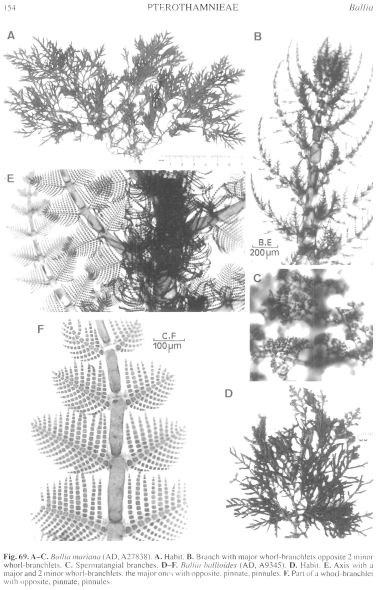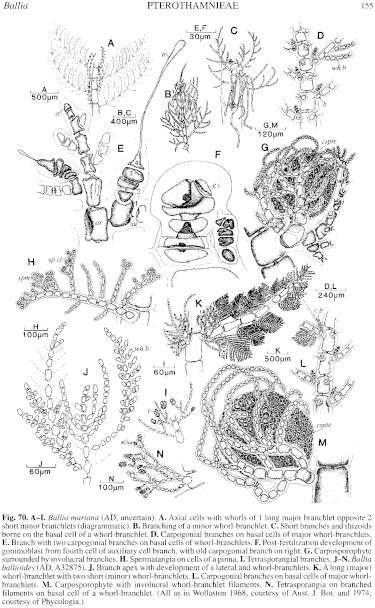|
|
|
|
|
|||||||||||
|
Electronic Flora of South Australia Species Fact Sheet
Phylum Rhodophyta – Order Ceramiales – Family Ceramiaceae – Tribe Pterothamnieae
Selected citations: J. Agardh 1876: 58. De Toni 1903: 1394. Guiler 1952: 97. Lucas 1909: 51; 1929b: 52. Lucas & Perrin 1947: 350. May 1965: 367. Reinbold 1898: 51. Sonder 1881: 11. Tate 1882: 17. Tisdall 1898: 502. Wilson 1892: 186. Wollaston 1968: 313, fig. 22A–E; 1974: 23, figs 1–14.
Thallus (Fig. 69A) medium to dark red-brown to grey-brown, erect, 5–20 cm high, more or less complanately branched above, densely rhizoidally corticated below, with each axial cell bearing a whorl of 3 whorl-branchlets (Fig. 69B, 70A), one longer major pinna opposite a pair of shorter minor pinnae. Holdfast of entwined rhizoids, 2–15 mm across with several axes; epilithic. Structure. Apical cells 25–40 µm in diameter and L/D 0.8–1.2, enlarging rapidly and to 180–250 µm in diameter and L/D (0.8–) 1.5–2 in lower axial cells; corticating rhizoids (Fig. 70C) 40–50 µm in diameter, cells long. Whorl-branchlets upwardly curved, the major ones 1–1.7 mm long, more or less distichous on the axes and overlapped by minor pinnae on the lower axial cell, with each rachis cell bearing a whorl of 3 pinnules in longitudinal rows, the upper pinnules with alternate or opposite branches; minor pinnae (Fig. 70B) branched similarly to major pinnae, with 2 or 3 rows of branches on the pinnules; basal cells of rachis 40--70 µm in diameter and L/D 0.6–1, upper cells L/D 1.5–2.5, tapering to subterminal cells of pinnules 8–15 µm in diameter and L/D 1–1.2, terminal cells rounded, cells of pinnule branches 10–13 µm in diameter and L/D 0.8–1.3. Lateral branches develop in place of major pinnae. Cells uninucleate; rhodoplasts discoid, in chains in larger cells.
Reproduction: Gametophytes dioecious. Carpogonial branches (Fig. 70E) borne on the basal (= supporting) cells of successive major pinnae (Fig. 69D). Post-fertilization an auxiliary cell branch is formed and fusion occurs between the carpogonium and the second cell of this branch, and the fourth cell of the branch (Fig. 70F) produces successive gonimolobes 300–500 µm across of ovoid carposporangia 10–15 µm across. The supporting cell also produces 2 involucral branches and these, together with the major pinna which produced the carpogonial branch, form an involucre around the carposporophyte (Fig. 70G). Spermatangia (Figs 69C, 701–1) are cut off from initials in small groups on cells of the rachis or pinnules.
Tetrasporangia (Fig. 70I) are terminal on special short branches on the basal cells of the rachides, ovoid, 25–35 µm in diameter, decussately divided.
Type from Port Fairy, Vic. (Harvey); lectotype in Herb. Harvey, TCD.
Selected specimens: St Francis I., Isles of St Francis, S. Aust., 55 m deep (Shepherd, 9.i.1971; AD, A38080). Pearson Is, S. Aust., 35 m deep (Shepherd, 7.i.1969; AD, A34029). Thistle I., S. Aust., 16 m deep (Baldock, 2.i.1964; AD, A27180). West I., S. Aust., 20 m deep (Shepherd, 17.viii.1968; AD, A32637). Pelorus I., S of Kangaroo I., S. Aust., 10–30 m deep (Branden, 19.vi.1991; AD, A61403). Robe, S. Aust., drift (Wollaston, 19.v.1964; AD, A27838). Stinky Bay, Nora Creina, S. Aust., drift (Parsons, 9.0.1968; AD, A32544 and Wollaston, 27.i.1969; AD, A33395). Port MacDonnell, S. Aust., drift (Womersley, 28.i.1964; AD, A27409). San Remo, Vic., drift (Sinkora A453, 14.vi.1970; AD, A45957). Eddystone, Tas. (Perrin, Nov. 1949; AD, A49648). Fluted Cape, Bruny I., Tas., 16 m deep (Shepherd, 10.0.1972; AD, A41507).
Distribution: St Francis I., S. Aust., to San Remo, Vic., and around Tasmania.
References:
AGARDH, J.G. (1876). Species Genera et Ordines Algarum. Vol. 3, Part 1- Epicrisis systematic Floridearum, pp. i-vii, 1–724. (Weigel: Leipzig.)
DE TONI, G.B. (1903). Sylloge Algarum omnium hucusque Cognitarum. Vol. 4. Florideae. Sect. 3, pp. 775–1521 + 1523–1525. (Padua.)
GUILER, E.R. (1952). The marine algae of Tasmania. Checklist with localities. Pap. Proc. R. Soc. Tasmania 86, 71–106.
HARVEY, W.H. (1855b). Short characters of some new genera and species of algae discovered on the coast of the Colony of Victoria, Australia. Ann. Mag. Nat. Hist. 15 (ser. 2), 332–336.
HARVEY, W.H. (1862). Phycologia Australica. Vol. 4, Plates 181–240. (Reeve: London.)
LUCAS, A.H.S. & PERRIN, F. (1947). The Seaweeds of South Australia. Part 2. The Red Seaweeds. (Govt Printer: Adelaide.)
LUCAS, A.H.S. (1909). Revised list of the Fucoideae and Florideae of Australia. Proc. Linn. Soc. N.S.W. 34, 9–60.
LUCAS, A.H.S. (1929b). A census of the marine algae of South Australia. Trans. R. Soc. S. Aust. 53, 45–53.
MAY, V. (1965). A census and key to the species of Rhodophyceae (red algae) recorded from Australia. Contr. N.S.W. natn. Herb. 3, 349–429.
REINBOLD, T. (1898). Die Algen der Lacepede und Guichen Bay (Slid Australien) und deren näherer Umgebung, gesammelt von Dr. A. Engelhart-Kingston. II. Nuova Notarisia 9, 33–54.
SONDER, O.W. (1881). In Mueller, F., Fragmenta Phytographiae Australiae. Supplementum ad volumen undecinum: Algae Australianae hactenus cognitae, pp. 1–42, 105–107. (Melbourne.)
TATE, R. (1882). A list of the charas, mosses, liverworts, lichens, fungs, and algals of extratropical South Australia. Trans. R. Soc. S. Aust. 4, 5–24.
TISDALL, H.T. (1898). The algae of Victoria. Rep. 7th Meet. Aust. Ass. Adv. Sci., Sydney, 1898, pp. 493–516.
WILSON, J.B. (1892). Catalogue of algae collected at or near Port Phillip Heads and Western Port. Proc. R. Soc. Vict. 4, 157–190.
WOLLASTON, E.M. (1968).Morphology and taxonomy of southern Australian genera of Crouanieae Schmitz (Ceramiaceae, Rhodophyta). Aust. J. Bot. 16, 217–417.
WOLLASTON, E.M.(1974). Sexual reproduction in Ballia mariana Harvey and Ballia ballioides (Sonder) Wollaston (Ceramiaceae, Rhodophyta). Phycologia 13, 21–26.
The Marine Benthic Flora of Southern Australia Part IIIC complete list of references.
Publication:
Womersley, H.B.S. (24 December, 1998)
The Marine Benthic Flora of Southern Australia
Rhodophyta. Part IIIC. Ceramiales – Ceramiaceae, Dasyaceae
©State Herbarium of South Australia, Government of South Australia
Illustrations in Womersley Part IIIA, 1998: FIGS 69 A–C, 70 A–I.

Figure 69 enlarge
Fig. 69. A–C. Ballia mariana (AD, A27838). A. Habit. B. Branch with major whorl-branchlets opposite 2 minor whorl-branchlets. C. Spermatangial branches. D–F. Ballia ballioides (AD, A9345). D. Habit. E. Axis with a major and 2 minor whorl-branchlets, the major ones with opposite, pinnate, pinnules. F. Part of a whorl-branchlet with opposite, pinnate, pinnules.

Figure 70 enlarge
Fig. 70. A–I. Ballia mariana (AD, uncertain). A. Axial cells with whorls of 1 long major branchlet opposite 2 short minor branchlets (diagrammatic). B. Branching of a minor whorl-branchlet. C. Short branches and rhizoids borne on the basal cell of a whorl-branchlet. D. Carpogonial branches on basal cells of major whorl-branchlets. E. Branch with two carpogonial branches on basal cells of whorl-branchlets. F. Post-fertilization development of gonimoblast from fourth cell of auxiliary cell branch, with old carpogonial branch on right. G. Carposporophyte surrounded by involucral branches. H. Spermatangia on cells of a pinna. I. Tetrasporangial branches. J–N. Ballia ballioides (AD, A32875). J. Branch apex with development of a lateral and whorl-branchlets. K. A long (major) whorl-branchlet with two short (minor) whorl-branchlets. L. Carpogonial branches on basal cells of major whorl-branchlets. M. Carposporophyte with involucral whorl-branchlet filaments. N. Tetrasporangia on branched filaments on basal cell of a whorl-branchlet. (All as in Wollaston 1968, courtesy of Aust. J. Bot. and 1974, courtesy of Phycologia.)

|
Email Contact: State Herbarium of South Australia |

|